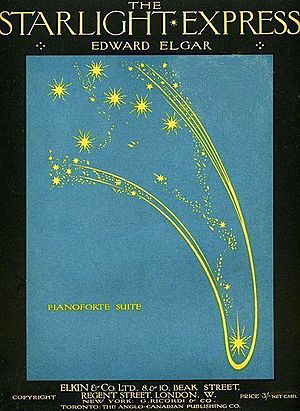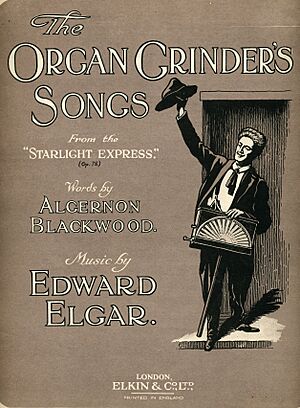The Starlight Express facts for kids
The Starlight Express is a special play for children. It was written by Violet Pearn and is based on a magical book called A Prisoner in Fairyland by Algernon Blackwood. The famous English composer Sir Edward Elgar wrote all the songs and background music for the play in 1915.
Contents
Who Are the Characters?
The play features these characters:
- Daddy (named "John Henry Campden," he's a writer)
- Mother (his wife, "Henrietta")
- Jane Anne ("Jinny," their oldest daughter, 17 years old)
- Monkey (their youngest daughter, 12 years old)
- Jimbo (their son, 10 years old)
- Grannie (Henrietta's Irish mother)
- Cousin Henry ("Henry Rogers," Daddy's cousin)
- Madame Jequier (a widow who owns the Pension Wistaria, a type of guesthouse)
- The Organ-Grinder (a street musician)
- Children (sometimes called 'Street Arabs') who are with the Organ-Grinder
- Miss Waghorn and three other retired Governesses (teachers)
- The Pleiades (dancers, like the star cluster)
- Sprites: These are magical helpers like the Tramp, the Lamplighter, the Gardener, the Dustman, the Sweep, the Woman-of-the-Haystack, Little Winds, and Laugher.
What Songs Are in the Play?
Here are the main songs from The Starlight Express:
Act I Songs
- Organ Grinder (sings): "To the Children" – "O children, open your arms to me,"
Act II Songs
- Organ Grinder: "The Blue-Eyes Fairy" – "There's a fairy that hides"
Act II Scene 1 Songs
- Organ Grinder: "Curfew Song" (about Orion) – "The sun has gone"
- Laugher (sings): "The Laugher's Song" – "I'm ev'rywhere"
- Organ Grinder: "Come Little Winds" – "Wake up you little night winds"
Act II Scene 3 Songs
- Laugher: "Tears and Laughter" – "Oh! stars shine brightly!"
- Jane Anne (sings): "Sunrise Song" (or "Dawn Song") – "We shall meet the morning spiders"
Act III Songs
- Organ Grinder: "My Old Tunes" – "My old tunes are rather broken"
Act III Scene 1 Songs
- Jane Anne: – "Dandelions, daffodils"
Act III Scene 2 Songs
- Laugher: – "Laugh a little ev'ry day"
- Organ Grinder: "The Dawn" – "They're all soft-shiny now"
- Jane Anne: – "Oh, think Beauty"
Act III Finale Song
- Jane Anne & Cousin Henry (sing together): "Hearts must be soft-shiny dressed" – "Dustman, Laugher, Tramp and busy Sweep"
What Happens in the Play?
Act I: Meeting the "Wumbled" Adults
The play begins with the Organ Grinder singing "To the Children." He talks about how grown-ups can be tired and forget their childhood dreams.
Scene 1: Worried Grown-Ups
The story takes place in a guesthouse (a pension) in the Swiss mountains. The grown-ups there are full of problems. Daddy is a writer who isn't doing well, and Mother has many worries. The guesthouse owner, Widow Jequier, has guests who don't pay. Old Miss Waghorn is always looking for her lost brother.
The children in the play see themselves as stars. Jane Anne is like the Pleiades star cluster, Jimbo is the Pole Star, and Monkey is the Great and Little Bear. Cousin Henry is seen as Orion.
The children notice that the adults are "wumbled," which means they are worried and confused. The children believe the adults need "sympathy" in the form of "star-dust" to feel better. This act has no songs, only background music.
Act II: The Blue-Eyes Fairy and Sprites
Before the second act starts, the Organ Grinder sings a waltz song called "The Blue-Eyes Fairy." This song is about a tiny fairy that lives in the eyes of kind children. This fairy can make people feel young and happy again.
Scene 1: The Star-Cave and Magical Helpers
Cousin Henry, Monkey, and Jimbo are outside a Star-Cave near a pine forest. They fall asleep. As night falls, magical Sprites appear, and the Organ-Grinder sings the "Curfew Song."
The Sprites then come down from the "Starlight Express." These Sprites are special helpers:
- The Organ Grinder: He loves all children and helps them find their way.
- The Sweep: He sweeps away worries.
- The Dustman: He carries the special "star-dust" of sympathy.
- The Lamplighter: He lights up hope and the stars.
- The Head Gardener: He helps good things grow.
- The Tramp: He represents simple, natural wisdom.
- The Laugher: She sings away troubles and brings joy.
- The Woman-of-the-Haystack: She is like the mother of all the Sprites.
The Laugher sings "I'm everywhere," explaining how laughter can solve problems. The Organ Grinder then sings "Come Little Winds," asking the winds to help the Woman-of-the-Haystack get to the cave.
Scene 2: Spreading Stardust
The Sprites enter the Star-Cave and sprinkle stardust on the sleeping villagers. The Dustman gives special dust to Miss Waghorn, helping her rest from her long search. The Lamplighter leaves to light up "the fires that are going out round the world," meaning he brings hope.
Scene 3: Tears, Laughter, and Dawn
The Laugher sings "Tears and Laughter," explaining that sad tears can actually be laughter that has gone missing. She hopes her song will help the "wumbled" world find its way back to Fairyland.
Then, Jane Anne sings the "Dawn Song," talking about "morning spiders" collecting thoughts and bringing the new day. The act ends as the curtain falls.
Act III: Hope and Transformation
After a short musical introduction, the Organ Grinder sings "My Old Tunes." He sings about his old songs bringing back memories of children dancing with Sprites under the moon. He says his tunes are never forgotten and still make children happy.
Scene 1: Dandelions and Daffodils
The curtain rises on Jane Anne, who sings about "Dandelions, daffodils," and other yellow flowers.
Scene 2: The Power of Beauty and Laughter
In the final scene, set in the pine forest by the Star Cave at night, Madame Jequier is happy because Cousin Henry has secretly paid all her guesthouse debts. Daddy speaks about how our true life is spiritual and connected to a "universal consciousness."
The Laugher sings "Laugh a little ev'ry day," encouraging everyone to laugh at themselves. The Organ Grinder then sings "The Dawn," saying that everyone's hearts are now "soft-shiny" and ready for a new kind of dawn. Jane Anne sings "Oh, think Beauty," reminding everyone that thinking beautiful thoughts is important.
Finale: Hearts Dusted with Joy
The stone covering the Star-cave is rolled away, and the scene becomes bright as the Sprites and humans enter. Even the ghost of Miss Waghorn appears, glowing with light.
Jane Anne and Cousin Henry sing a duet called "Hearts must be soft-shiny dressed." They sing about the Sprites helping the world wake up from its troubles. They ask the Sprites to sow the earth's gardens with "joy and trust," bringing "Love, Laughter, Courage, Hope." The song ends with the idea that hearts should be "soft-shiny dressed" with "golden dust" for the "rising of the star."
As the play ends, the Star of Bethlehem appears, and the music of the Christmas carol "The First Nowell" blends into the score.
What People Thought About the Play
A reviewer from Punch magazine in 1916, named Joseph Thorp, wrote about The Starlight Express. He said that even though it was hard to put all of the author's ideas on stage, the play had "beautiful moments."
He explained that the play wanted to show how to cure "wumbledness" – when people are negative or selfish. The cure was "stardust," which means sympathy. The children and Cousin Henry found this cure. To get the stardust, you had to go into a special cave with the help of the Organ Grinder and other Sprites like the Gardener, Lamplighter, Sweep, and Dustman. Once you sprinkled this stardust on people, they became happy and unselfish.
The reviewer praised Sir Edward Elgar's music, saying it created a wonderful atmosphere. He also liked the lighting and stage design. He especially mentioned Mr. Charles Mott as the Organ-Grinder, saying he sang beautifully to a sweet group of children.
He also thought Mercia Cameron (Jane Anne) did a great job showing the play's mystery. Ronald Hammond (Jimbo) was lively, and Elsie Hall (Monkey) was also good. O. B. Clarence played Daddy well, and Owen Roughwood showed that he believed in the power of stardust. The reviewer wondered if the children in the audience liked it, hoping they didn't feel tricked, but said the older children enjoyed it very much.
What Happened After the Play?
- The writers, Blackwood and Pearn, worked together on other plays later, like Karma and Through The Crack.
- Sadly, Charles Mott, the singer who played the Organ Grinder, was badly wounded in World War I and died in 1918. He was 37 years old. Elgar was very sad about his death.
- In 1933, a conductor named Joseph Lewis created a 40-minute music selection from The Starlight Express for BBC radio. However, his music and other BBC materials were destroyed during an air-raid in 1940.
- In September 1940, the Kingsway Theatre, where the play was performed, was damaged by fire in an air raid. All the stage props and music scores (except Elgar's original manuscript) were destroyed. Luckily, Elgar had left his full music score with his publishers, so it survived. Elgar had even signed the score with "AE 15," meaning "Age 15," showing he felt like a child again when writing it!
- In 1984, Richard Adams wrote a story to go along with a performance of Elgar's music in the Netherlands.
Music Recordings
Over the years, many recordings of the songs and music from The Starlight Express have been made.
- The first recordings were made in 1916, with Charles Mott and Agnes Nicholls singing, and Elgar himself conducting.
- More recordings were made in 1935, 1946, and 1964.
- In 1973, Chandos Records recorded some of the songs.
- A complete recording of the play's music was made by EMI/HMV in 1974–1975, featuring Derek Hammond-Stroud and Valerie Masterson with the London Philharmonic Orchestra.
- In 1990, Decca Records made another recording with famous singers like Bryn Terfel and Alison Hagley.
- In 1992, the orchestral parts were recorded by the Indianapolis Symphony Orchestra.
- The 1990 Decca recording was improved in 1997.
[[scores:{{{id}}}|The Starlight Express]]: Free scores at the International Music Score Library Project



